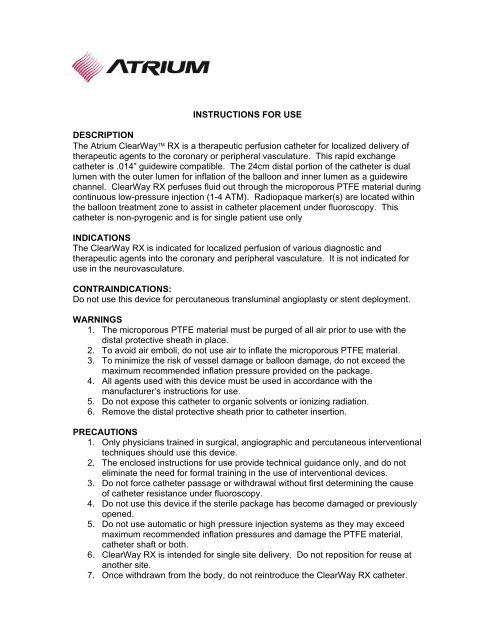INSTRUCTIONS FOR USE DESCRIPTION The Atrium ClearWay ...
INSTRUCTIONS FOR USE DESCRIPTION The Atrium ClearWay ...
INSTRUCTIONS FOR USE DESCRIPTION The Atrium ClearWay ...
You also want an ePaper? Increase the reach of your titles
YUMPU automatically turns print PDFs into web optimized ePapers that Google loves.
<strong>INSTRUCTIONS</strong> <strong>FOR</strong> <strong>USE</strong><br />
<strong>DESCRIPTION</strong><br />
<strong>The</strong> <strong>Atrium</strong> <strong>ClearWay</strong> RX is a therapeutic perfusion catheter for localized delivery of<br />
therapeutic agents to the coronary or peripheral vasculature. This rapid exchange<br />
catheter is .014” guidewire compatible. <strong>The</strong> 24cm distal portion of the catheter is dual<br />
lumen with the outer lumen for inflation of the balloon and inner lumen as a guidewire<br />
channel. <strong>ClearWay</strong> RX perfuses fluid out through the microporous PTFE material during<br />
continuous low-pressure injection (1-4 ATM). Radiopaque marker(s) are located within<br />
the balloon treatment zone to assist in catheter placement under fluoroscopy. This<br />
catheter is non-pyrogenic and is for single patient use only<br />
INDICATIONS<br />
<strong>The</strong> <strong>ClearWay</strong> RX is indicated for localized perfusion of various diagnostic and<br />
therapeutic agents into the coronary and peripheral vasculature. It is not indicated for<br />
use in the neurovasculature.<br />
CONTRAINDICATIONS:<br />
Do not use this device for percutaneous transluminal angioplasty or stent deployment.<br />
WARNINGS<br />
1. <strong>The</strong> microporous PTFE material must be purged of all air prior to use with the<br />
distal protective sheath in place.<br />
2. To avoid air emboli, do not use air to inflate the microporous PTFE material.<br />
3. To minimize the risk of vessel damage or balloon damage, do not exceed the<br />
maximum recommended inflation pressure provided on the package.<br />
4. All agents used with this device must be used in accordance with the<br />
manufacturer’s instructions for use.<br />
5. Do not expose this catheter to organic solvents or ionizing radiation.<br />
6. Remove the distal protective sheath prior to catheter insertion.<br />
PRECAUTIONS<br />
1. Only physicians trained in surgical, angiographic and percutaneous interventional<br />
techniques should use this device.<br />
2. <strong>The</strong> enclosed instructions for use provide technical guidance only, and do not<br />
eliminate the need for formal training in the use of interventional devices.<br />
3. Do not force catheter passage or withdrawal without first determining the cause<br />
of catheter resistance under fluoroscopy.<br />
4. Do not use this device if the sterile package has become damaged or previously<br />
opened.<br />
5. Do not use automatic or high pressure injection systems as they may exceed<br />
maximum recommended inflation pressures and damage the PTFE material,<br />
catheter shaft or both.<br />
6. <strong>ClearWay</strong> RX is intended for single site delivery. Do not reposition for reuse at<br />
another site.<br />
7. Once withdrawn from the body, do not reintroduce the <strong>ClearWay</strong> RX catheter.
POSSIBLE COMPLICATIONS<br />
• Hematoma at the access point<br />
• Acute myocardial infarction<br />
• Spontaneous thrombus formation<br />
and occlusion of the artery, vein or<br />
graft<br />
• Cerebral circulatory disorders<br />
• Unknown side effects with regard to<br />
various irrigating solutions and<br />
concentrations<br />
• Possible flow surface disruption<br />
• Hypotension<br />
• Ischemia<br />
• Palpitations<br />
• Vessel dissection<br />
• Anastomotic rupture or injury<br />
• Restenosis<br />
• Hemorrhage or hematoma<br />
• Unstable angina<br />
• Arrhythmias<br />
• Allergic reaction to contrast medium<br />
• Infection<br />
• Coronary artery spasm<br />
• Embolism<br />
• Death<br />
DIRECTIONS <strong>FOR</strong> <strong>USE</strong><br />
A. BALLOON PREPARATION<br />
1. Remove catheter from the package<br />
2. A 10cc or larger syringe, or low pressure inflation device is recommended for use<br />
with this catheter.<br />
3. <strong>The</strong> <strong>ClearWay</strong> RX catheter must be primed and purged of all air with sterile fluid<br />
prior to patient use with the distal protective sheath in place. Do not exceed 1<br />
ATM.<br />
4. <strong>The</strong> distal protective sheath must be kept in place over the PTFE balloon<br />
material during all purging steps.<br />
5. Do not pull a vacuum on the syringe when purging the PTFE balloon material.<br />
6. Prior to insertion remove the distal protective sheath and visually inspect the<br />
PTFE balloon material for any damage.<br />
B. CATHETER INSERTION<br />
1. See corresponding package label for guidewire and guide catheter compatibility.<br />
2. If necessary, the guidewire lumen can be irrigated with sterile saline solution prior<br />
to patient use.<br />
3. Carefully introduce the <strong>ClearWay</strong> RX catheter tip onto the guidewire and insert.<br />
4. Under fluoroscopy advance the microporous balloon segment to the desired<br />
treatment location. Once placement is confirmed using the radiopaque markers,<br />
infusion can begin.<br />
5. Infuse prescribed amount of fluid. Do not exceed the maximum recommended<br />
pressure found on the corresponding package label.<br />
6. Once the prescribed volume of fluid has been infused, immediately release<br />
syringe pressure by pulling back on the syringe barrel.<br />
7. After infusion is complete, ensure that the device is deflated prior to withdrawal.<br />
8. <strong>The</strong> <strong>ClearWay</strong> RX catheter is for single site infusion only.<br />
STORAGE<br />
Store in a cool, dry place away from intense light.



